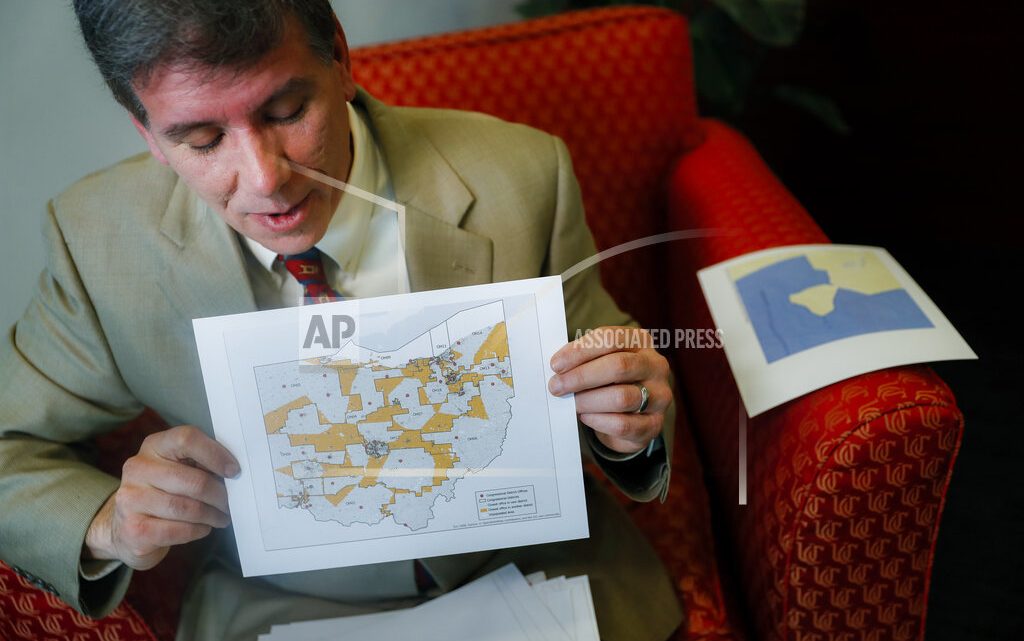By DAVID A. LIEB Associated Press
Eds: UPDATES: With AP Photos. A longer version of this story is available.
JEFFERSON CITY, Mo. (AP) — The reins of political power in the U.S. for the next decade could be determined in this year’s elections — not necessarily by who wins the presidency, but by thousands of lower-profile contests for state legislative seats across the country.
In many states, the winners of those legislative races will have a role in drawing new districts for Congress or state legislatures based on the 2020 census. If a political party can win control of those state legislative chambers now, it can draw voting districts to boost its chances in future elections.
“The 2020 election is the premier election when it comes to redistricting, because it is the election that will set the players in place who will do redistricting come 2021,” said Wendy Underhill, director of elections and redistricting for the National Conference of State Legislatures.
Voters will be electing more than 5,000 state lawmakers in 35 states who will play a significant role in crafting or passing new maps for Congress or state House and Senate districts. Voters also will be electing governors in eight states who could enact or veto those maps.
The Constitution requires a census once every 10 years. That population count then is used to redraw districts for the U.S. House of Representatives and state legislative chambers. States that grow rapidly can gain congressional seats while those that fail to keep pace can lose seats. Migration among cities, suburbs and rural areas also can lead to changes in district lines to try to equalize the number of residents in each voting jurisdiction.
Seven states have only one congressional district because of their small populations. Of the remaining 43 states, eight use redistricting commissions for Congress that leave little or no role for the state legislature. Eleven of the 50 states rely on independent commissions for redistricting their state House and Senate seats. The rest involve lawmakers in the process, and most also give governors a say.
Republicans generally outmaneuvered Democrats during the last round of redistricting by converting big wins in the 2010 state elections into favorable maps for the future. Democrats successfully challenged some of those maps in court, forcing them to be redrawn.
This time, Democrats are pouring more money into the redistricting fight. The Democratic Legislative Campaign Committee has boosted its fundraising target from about $10 million during the 2009-2010 election cycle to $50 million in the 2019-2020 elections. Various Democratic-aligned groups are kicking in tens of millions more, including the National Democratic Redistricting Committee led by former Obama administration Attorney General Eric Holder.
The Republican State Leadership Committee, which calls its redistricting campaign “Right Lines 2020,” hasn’t disclosed a fundraising goal for the year. But it had a target of as much as $50 million for state legislative and down-ballot statewide races during the 2017-18 election cycle.
THE BIG FOUR
Four of the biggest redistricting prizes in the 2020 legislative elections are Texas, Florida, North Carolina and Georgia. Those states combined account for 90 U.S. House seats, one-fifth of the nationwide total, and Republicans currently hold more than 60% of them. Texas, Florida and North Carolina all are projected to gain congressional seats because of their population growth, which would give the party in power an opportunity to shape new districts to their liking.
All four states have complete Republican control in their state legislatures, giving them an edge in redistricting, although Florida’s constitution says districts can’t be drawn to favor a political party.
In North Carolina, all congressional and some state legislative candidates will be running under newly redrawn districts this year after state courts stopped the use of prior maps drawn by the Republican-led Legislature. Democrats had argued that the old districts were an example of extreme partisan gerrymandering. Republicans hold 10 of North Carolina’s 13 seats in the U.S. House, even though statewide elections between Republicans and Democrats are usually close.
MARGINS MATTER
Ohio has long been a top redistricting target for the political parties. After the 2010 census, Republicans controlled the House, Senate, governor’s office and other key executive offices that gave them firm control over redistricting. Republicans still control Ohio government.
But a pair of constitutional amendments approved by voters since the last census have changed the redistricting process to inject greater bipartisanship. After the 2020 census, a congressional redistricting plan must receive a 60% vote in both the House and Senate — including support from at least half the minority party members in each chamber — to last for the full decade. A similar bipartisan threshold is required from the commission of elected officials that handles state legislative redistricting.
Winning control of the Ohio House or Senate would be difficult for Democrats, yet each seat they can gain will increase the number of Democratic votes needed for the Republican majorities to enact new districts.
Slim margins also could make a big difference in the historically Republican state of Kansas. Gov. Laura Kelly, a Democrat, will be able to veto redistricting plans passed by the Republican-led Legislature. But at the moment, the GOP hold a two-thirds majority needed to override a veto.
REDISTRICTING BYSTANDERS
The 2020 elections won’t matter at all in some states — at least not when it comes to redistricting. That’s the case in the nation’s most populous state of California, which will use a 14-member citizens commission to draw its congressional and state legislative districts after the 2020 census.
Michigan had been expected to be a big redistricting battleground in the 2020 legislative elections. But a ballot measure approved in 2018 by voters created an independent commission to handle the task that had previously been the domain of the legislature and governor. Other states with independent redistricting commissions include Arizona, Colorado, Hawaii, Idaho, Montana, New Jersey and Washington.
___
Follow David A. Lieb at: https://twitter.com/DavidALieb
[livemarket market_name="KONK Life LiveMarket" limit=3 category=“” show_signup=0 show_more=0]



No Comment